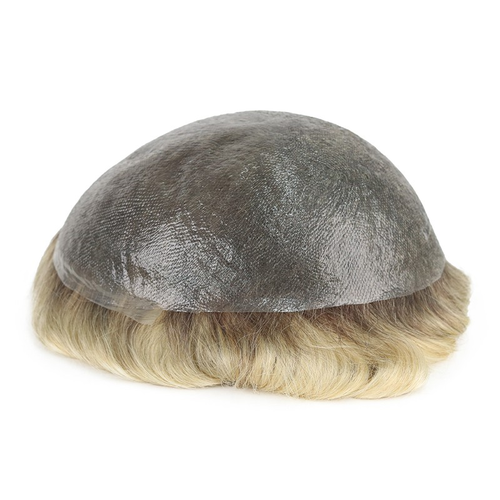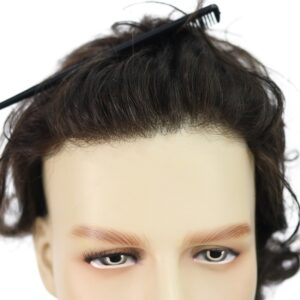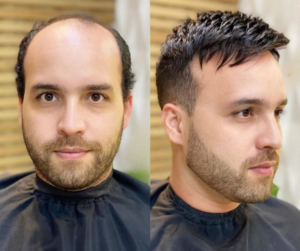Wig Health Check: Know When to Bid Farewell to Your Toupee
Are you also wondering how often toupee for man should be replaced? In fact, wigs made of different materials have different lifespans, plus the influence of some external factors leads to the use of wigs for each person not at the same time, this blog will explain to you when the wig appears when the situation means that it should be replaced.

1. Hair loss and bald spots
Excessive hair loss and bald areas on a wig indicate that it is nearing the end of its life. As you wear the wig for longer and longer lengths of time, the integrity of the hair strands can deteriorate, resulting in wig hair loss or bald areas. If you notice a lot of hair loss without realizing it or notice some areas of your scalp are bare, it is clear that you need to replace your wig.
2. Hair texture decreases or looks dry
A wig has its own shine, and its shine has a great impact on its own authenticity. When you start to observe a decline in the quality of your toupee’s hair—perhaps noticing a lack of sheen or a dry appearance—it serves as a clear indicator that your toupee has surpassed its prime. Similar to our natural hair, which requires consistent moisturizing and care, wig hair demands meticulous attention to maintain a vibrant and authentically healthy look. Just as we nurture our own locks to keep them radiant and lively, the hair of a wig necessitates continuous care and upkeep to ensure it retains a bright and naturally appealing appearance.
3. Toupee color fading
As a wig is worn over an extended period, it’s entirely natural for its color to fade gradually. Prolonged exposure to the sun, in particular, subjects the toupee to the bleaching impact of UV rays, triggering the fading process in the pigmentation of the wig fibers. The consequence of this fading is a wig that appears lackluster and loses its vitality, detracting from its overall healthy and natural appearance. To counteract this gradual color shift, regular and meticulous maintenance becomes crucial. Employing proper care practices helps mitigate the impact of these factors and slows down the natural fading progression. Understanding that a wig, like natural hair, may evolve in color over time is important. However, taking proactive measures to preserve its vibrancy through conscientious care routines ensures an extended period of enjoying the desired look. Regular maintenance, protective measures against excessive sunlight, and the use of recommended hair care products collectively contribute to prolonging the vibrancy and aesthetic appeal of the wig.
4. The base is more prone to tearing
The foundation of a toupee lies in its base, which serves as a fundamental element providing structure and support. Any form of damage to the base poses a significant threat to the overall integrity of the toupee, potentially diminishing its value. The base, acting as the backbone, plays a crucial role in maintaining the wig’s form and stability. A notable warning sign that the toupee is nearing the end of its usable lifespan is when the base starts showing increased vulnerability to tearing, ripping, or other types of damage during wear. Such indications serve as an alert that the toupee is on the verge of experiencing a substantial breakdown. When the base is compromised, it not only adversely affects the visual appeal of the toupee but also undermines its structural stability. The compromised base raises the risk of the wig becoming less secure and more prone to falling out, ultimately impacting the wearer’s confidence and comfort. Regularly checking the integrity of the base is crucial for when to buy a new wig.

5. Difficult knots
Persistent and challenging knots can become a recurring issue with a wig, accumulating over time and proving resistant to conventional detangling efforts. Recognizing the prevalence of difficult knots is a key insight into the changing dynamics of the wig’s texture and structure. It indicates that the wig may have exhausted its capacity to retain a natural, elastic quality, and the persistent knots serve as a tangible signal of the wig’s declining health. Regular monitoring and addressing of these challenging tangles become crucial in managing the toupee’s appearance and ensuring a satisfactory user experience.
6. Loss of base flexibility
The elasticity of the base is essential for a secure and comfortable fit. If you notice that the base has lost its elasticity, causing the wig to become loose and unstable, replace the wig promptly.
Failure to restore freshness through cleaning
Even after thorough cleaning, a wig that still looks dull, and lackluster and cannot be conditioned to restore freshness may mean that the wig has lost its ability to recover.
Conclusion
In conclusion, the frequency of men’s wig replacement depends on many factors, ranging from hair loss in the wig itself, loss of hair texture, dryness of the hair, fading of the color, and so on. Recognizing these factors and making timely decisions to replace your wig is crucial. Acquiring a new wig isn’t just about aesthetic appeal; it’s also about ensuring comfort during wear. If you’re in search of a new wig, we invite you to explore our offerings at LaVivid, where we are dedicated to providing a comprehensive range of services to meet your needs.







